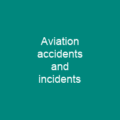What Exactly Is An Aircraft Pilot?
An aircraft pilot or aviator controls an aircraft’s flight by operating directional controls; this term also applies to navigators and engineers involved in navigation and engine systems, while other aircrew members are not considered aviators.
The Evolution of the Term ‘Aviator’
Did you know that the term ‘aviator’ originated from the Latin word avis, meaning bird? It first appeared in 1863 and was officially recorded for use in 1887. This term has come a long way, reflecting the evolution of aviation technology and its impact on society.
Awards and Recognition
Pilot badges are awarded to pilots as recognition of their qualifications. These badges serve not only as a symbol of achievement but also as a testament to years of dedication and hard work in the skies.
The Future of Pilots: Automation and AI
Automation could replace pilots and copilots as technology advances. Airlines and manufacturers are working on single-pilot cockpits and autonomous flight systems, which might drastically change the landscape of aviation. UBS predicts pilotless airliners will appear around 2025, offering $35 billion in savings.
Regulations need to adapt for air cargo, and passenger flights could be limited by consumer behavior. Some airlines plan to adopt reduced cockpit crews or single pilots for certain routes. The industry is still deciding how to proceed with automation and AI-powered systems. Pilotless aircraft require artificial intelligence with machine learning, while present systems are deterministic.
Single-pilot freighters may start with regional flights. In the United States, there were 691,691 active pilot certificates in 2023, down from a high of over 800,000 active pilots in 1980. Of these, 160,860 held private licenses, 103,879 had commercial licenses, 164,193 were airline transport pilots, and 222,629 were student pilots.
Military Pilots: A Different Path
Military pilots fly with the armed forces, primarily the air forces, of a government or nation-state. Their tasks involve combat and non-combat operations, including direct hostile engagements and support operations. Military pilots undergo specialized training, often with weapons.
Examples of military pilots include fighter pilots, bomber pilots, transport pilots, test pilots, and astronauts. Military pilots are trained with a different syllabus than civilian pilots, which is delivered by military instructors. This is due to the different aircraft, flight goals, flight situations, and chains of responsibility. Many military pilots do transfer to civilian-pilot qualification after they leave the military, and typically their military experience provides the basis for a civilian pilot’s license.
The Early Days of Bombing Missions
It was in France that the world’s first bombing group was created on November 23, 1914. The Voisin III were the only aircraft available for this mission. These could only carry very light loads (between 55-160 kg of bombs), the bombs were rudimentary and the aiming systems remained to be developed. Initially, the bombs were simply thrown overboard by the crew, with necessarily very limited accuracy.
Nevertheless, the beginnings of tactical and strategic bombing took place in the first days of the war. The Royal Naval Air Service (RNAS) carried out bombing missions of the hangars of the airports of Düsseldorf, Cologne, and Friedrichhafen during the autumn of 1914. The formation of the Brieftauben Abteilung Ostende (‘Ostend Carrier Pigeon Detachment’, name of code of the first German bombing units) carried out bombing missions over the English Channel in December 1914.
Unmanned Aerial Vehicles (UAVs)
Unmanned aerial vehicles (UAVs, also known as ‘drones’) operate without a pilot on board and are classed into two categories: autonomous aircraft that operate without active human control during flight and remotely piloted UAVs which are operated remotely by one or more persons. The person controlling a remotely piloted UAV may be referred to as its pilot or operator.
Depending on the sophistication and use of the UAV, pilots/operators of UAVs may require certification or training, but are generally not subject to the licensing/certification requirements of pilots of manned aircraft. Most jurisdictions have restrictions on the use of UAVs which have greatly limited their use in controlled airspace; UAVs have mostly been limited to military and hobbyist use.
The Future of Human Spaceflight
The general concept of an airplane pilot can be applied to human spaceflight as well. The pilot is the astronaut who directly controls the operation of a spacecraft. This term derives directly from the usage of the word ‘pilot’ in aviation, where it is synonymous with ‘aviator.’
Training and Certification
Pilots are required to go through many hours of flight training and theoretical study that differ depending on the country. The first step is acquiring the Private Pilot License (PPL), or Private Pilot Certificate. In the United States, this includes a minimum of 35 to 40 hours of flight training, the majority of which with a Certified Flight Instructor. In the United States, an LSA license can be obtained in 20 hours of flight time.
Pilots may pursue a Commercial Pilot License, Instrument Rating, or Multi-Engine Rating to advance their career. To captain an airliner, one must obtain an Airline Transport Pilot License. Some countries require a multi-crew cooperation certificate. Studies suggest that airline pilots’ life expectancy is not significantly lower than the general population, but higher mortality rates have been reported among military pilots.

As we look towards the future, one thing is certain: the role of pilots will continue to evolve. Will you be part of this exciting journey? The skies are not just the limit; they’re also full of endless possibilities.
You want to know more about Aircraft pilot?
This page is based on the article Aircraft pilot published in Wikipedia (retrieved on January 31, 2025) and was automatically summarized using artificial intelligence.





